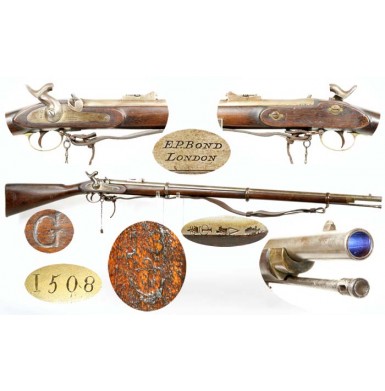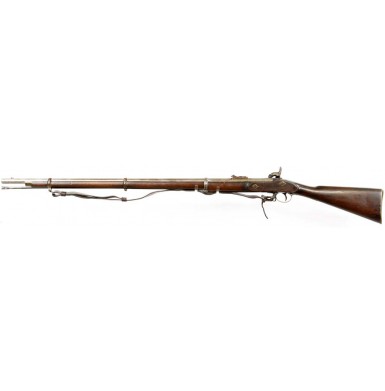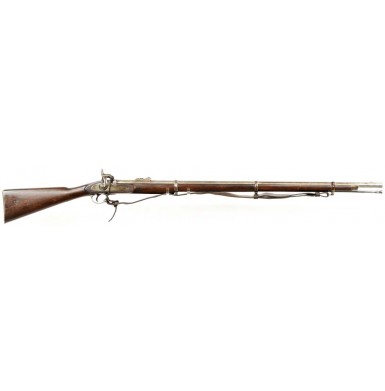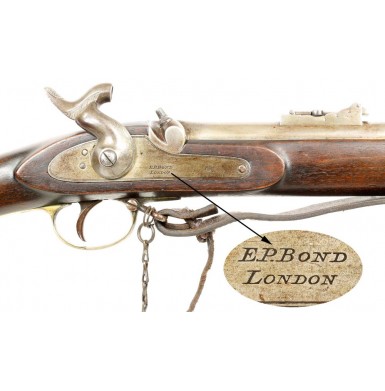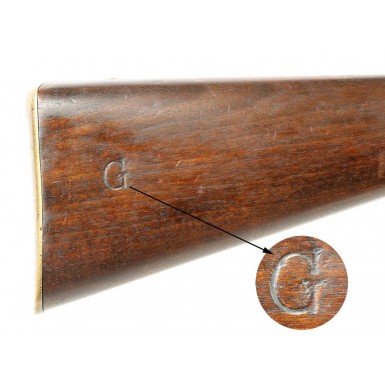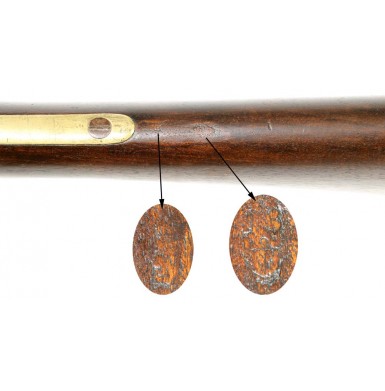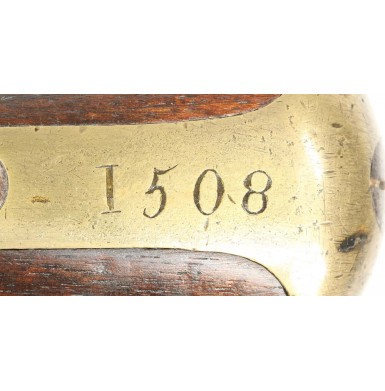While Confederate marked and imported Pattern 1853 Enfield rifle muskets are very scarce and always desirable collectibles, the rarest and most desirable of these guns are the ones purchased by individual southern states and marked with those state’s ownership marks. It is well known that early in the war the states of Georgia, South Carolina, North Carolina and Louisiana all acquired arms directly from England, functioning proactively to supply their troops that were rallying to the protect their states from Northern invasion. These guns had state ownership marks applied to them prior to their shipment to the Confederacy, in an attempt to keep the guns segregated from the Confederate central government purchases, and to ensure that the guns reached the troops of that specific state. The guns purchased by the state of Georgia are rarely encountered for sale, but they are some of the best documented of the Confederate state purchased arms.
In 1861, Major Edward C Anderson was sent to England to act as a Confederate central government purchasing agent of small arms and munitions. As Anderson was a Georgian, Georgia Governor Joseph E Brown relied upon Anderson to work as a purchasing agent for that state as well. During September of 1861 Anderson arranged the purchase of 5,500 “Enfield” pattern small arms through the firm of Sinclair, Hamilton & Company. Of these guns, 4,700 were Pattern 1853 “long” Enfield rifle muskets, and the remaining 800 were Pattern 1856 “short” Enfield rifles, which were apparently of the pattern known in the British military as Sergeant’s Fusils for India Service. Anderson returned to the Confederacy aboard the Confederate blockade runner Fingal on October 8, 1861. In addition to Anderson, the Fingal brought the first 1,100 guns of his purchase for the state of Georgia, as well as 1,000 that had been purchased by Louisiana and 7,520 that had been purchased by the Confederate central government. Among these guns that were on Fingal were the Georgia purchased “long” Enfields with the engraved inventory numbers 1-1000. These guns were shipped in crates of 20, complete with socket bayonets for each gun, a bullet mold and two nipple keys (cone wrenches). Based upon an analysis of the cargo manifest of the next Confederate blockade runner to deliver Enfields to the Confederacy, the Gladiator, it is probable that Fingal also carried the Georgia purchased “long” Enfields numbered 1121-1220. The crates that contained these Georgia purchased arms were marked with the initials
Based upon examination of the limited number of Georgia “G” marked P-1853 Enfield rifle muskets known to exist, it has been determined that #1-2000 and #3700-4700 were guns marked in the above manner. However, it appears that approximately 1700 guns (likely the guns numbered between 2000-3700) were delivered by the London gunmaker Barnett, and these guns have their numbers stamped on the toe of the buttplate, rather than being engraved on the top of the buttplate tang. These guns also bear a G mark on the obverse buttstock (but of a slightly larger size), and are marked with the CH / 1 inspection stamp in the wood, in front of the buttplate tang, instead of a JS/(ANCHOR). To date less than 70 “G” marked P1853 Enfields of all types are known to have survived, with less than 50 of the engraved number guns being known and less than 30 of the Barnett guns with stamped numbers being known. This observation is based upon some 25 years of surveying extant examples by several noted arms historians, and maintaining a very extensive database of these Confederate marked import arms.
The Georgia G Pattern 1853 Enfield Rifle Musket offered here was delivered by the blockade runner Gladiator and is inventory numbered 1508. The gun traveled to Nassau in case number 88 in the cargo hold of the Gladiator. Case 88 contained the guns numbered 1501-1520. This gun was delivered to Sinclair, Hamilton & Company by the famous London gunmaker E.P. BOND. The firm of Edward Philip Bond was one of the larger London gunmaking companies, which could trace their roots in the business to the early 1700s, when the first Bond of the family was “Freed of the Gunmakers Company” (released from apprenticeship, allowing him to work on his own and eventually be made a “master” gunmaker) in 1730. Over the next hundred years, the family flourished in the gun trade, and in 1835 Edward Philip Bond was apprenticed to his uncle William Thomas Bond. In 1836, Edward was turned over to John Edward Barnett to continue his apprenticeship and was free of the Gunmakers Company in 1842. The time Bond spent apprenticed to Barnett no doubt established the long-time relationship between the two companies that continued well into the American Civil War era, as both firms became major suppliers of arms to the Confederacy. According to the Gladiator manifest, crates number 84-88 were “furnished” by Bond. Four guns are known to have survived from the Bond furnished crate #88, three of which are Bond marked on the lock with the fourth having a TOWER / 1861 lock. To my knowledge all of the Bond marked guns from this crate have the initials R.T.P. stamped in the wood at the tail of the stock flat opposite the lock. The surviving guns from this crate indicate that Bond was sub-contracting at least some of the guns that he delivered on this contract. The “Tower” marked gun was likely manufactured in Birmingham (subcontracted for Bond) with the “RTP” marked guns being manufactured by R.T. Pritchett. This rifle musket bears Pritchett marks throughout, with the only “Bond” marking being found on the lock. The gun is not marked with a “B” for Bond furnishers mark on the top of the stock, forward of the buttplate tang. This is typical of early Bond deliveries to the Confederacy, which tend not to be furnisher marked if they are under inventory number 2000. The gun is clearly marked on the lock in two lines, forward of the hammer: E.P. BOND / LONDON. There is no “crown” to the rear of the hammer. The interior of the lock marked with the mating number 18, the initials PM, the name PRITCHETT, and with a single large P. The inside neck of the hammer is marked R.T.. The breech of the barrel is marked with the usual London commercial Provisional Proof, View, and Definitive Proof marks. The breech is also marked with a single P, which apparently stands for Pritchett. This “P” is identical to the one found inside the lock. The bottom of the barrel is marked by the famous English barrel making firm of BEASLEY BROS, and is additionally marked PRITCHETT, with the gauge number 25 for .577 caliber, 347P and with the mating number 18, matching the number inside the lock. The gun has a crisp and clear 5/8” tall Georgia G on the obverse buttstock, a legible JS / (ANCHOR) in the belly of the stock, behind the triggerguard and the inventory number 1508 engraved on the buttplate tang. The number is engraved in a small neat hand, and is typical of low numbered Bond furnished guns. The initials R.T.P. are barely legible, stamped at the tail of the counterpane, opposite the lock.
The gun is in about VERY GOOD+ condition overall. The metal of the gun has been very lightly cleaned a long time ago, and is almost entirely smooth throughout. There is only some light scattered peppering and pinpricking present on the barrel and bands. The metal has a medium gray patina and has no original finish present. The metal also shows scattered areas of lightly oxidized age discoloration and areas of brownish coloration. The lock functions crisply and is mechanically excellent, working perfectly on all positions. The bore of the gun rates about VERY GOOD as well. The bore is mostly bright, with strong rifling and only some light scattered pitting along its length. The gun retains the original long-range rear sight, which is marked W&S for Philip Webley & Son. The barrel bands all retain their original screw keepers at the ends, small items that are almost always missing. The gun also retains both of its original sling swivels, and sports an original English pattern leather sling, which ties onto the triggerguard and has one standing and one sliding loop for adjustment. An original period “snap cap” (cone or nipple protector) is secured by a chain to the rear sling swivel. The protector is complete, with only some loss to the leather padding. An original, period P-1853 ramrod is in place in the channel under the barrel. It is full length and retains good threads at the end. The original ramrod, which was numbered to the gun, is lost to the ages. The original, matching numbered ramrods are practically never found with numbered Enfields. During the war, the Confederacy imported thousands of replacement ramrods due to the proclivity of the soldiers to lose them or break them. The brass furniture is very attractive and has a lovely, mustard patina. The stock of the gun rates about VERY GOOD+ as well. It was lightly cleaned long ago, but does not appear to have been sanded. All of the stock markings remain relatively crisp, without any smearing or blurring. The edges remain strong, and any rounding appears to be from actual use, wear and tear. The stock is solid and full-length, with no breaks, cracks or repairs. The wood to metal fit is wonderful, and very tight throughout. The stock does show light to moderate handling marks, bumps and dings, but clearly was never abused or treated severely.
Overall, this is a really great example of an incredibly scarce Georgia “G” marked P-1853 Enfield Rifle Musket, which we know was shipped from England on board the Gladiator. These early Georgia marked guns were some of the first Enfields to arrive in the south, and their early delivery insured that they saw significant service during the course of the war. High quality Confederate Enfields are difficult to find for sale, but state marked guns are particularly difficult to locate. This is a wonderful and well-marked Georgia gun that is 100% original and correct (with the exception of the missing original numbered rod) and would certainly make a fantastic centerpiece to any advanced collection of Confederate long arms, especially a collection that emphasizes Confederate imports. A high resolution digital copy of the Gladiator manifest page, showing the Georgia guns on that ship, will be include with this gun and will significantly enhance the display.
SOLDTags: Confederate, Georgia, G, P1853, Enfield

